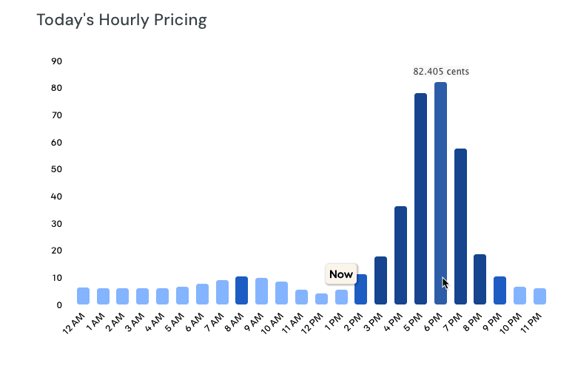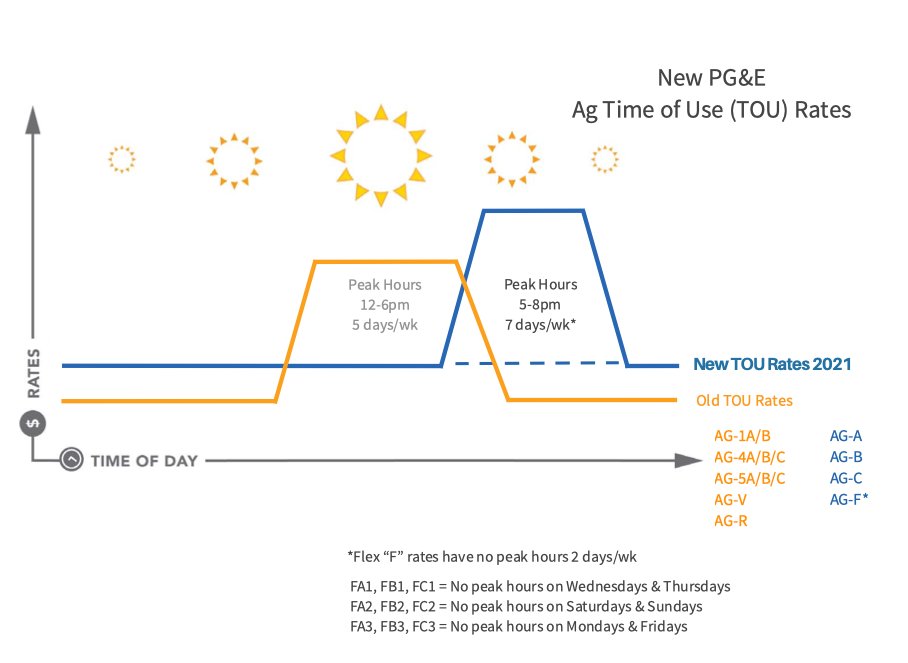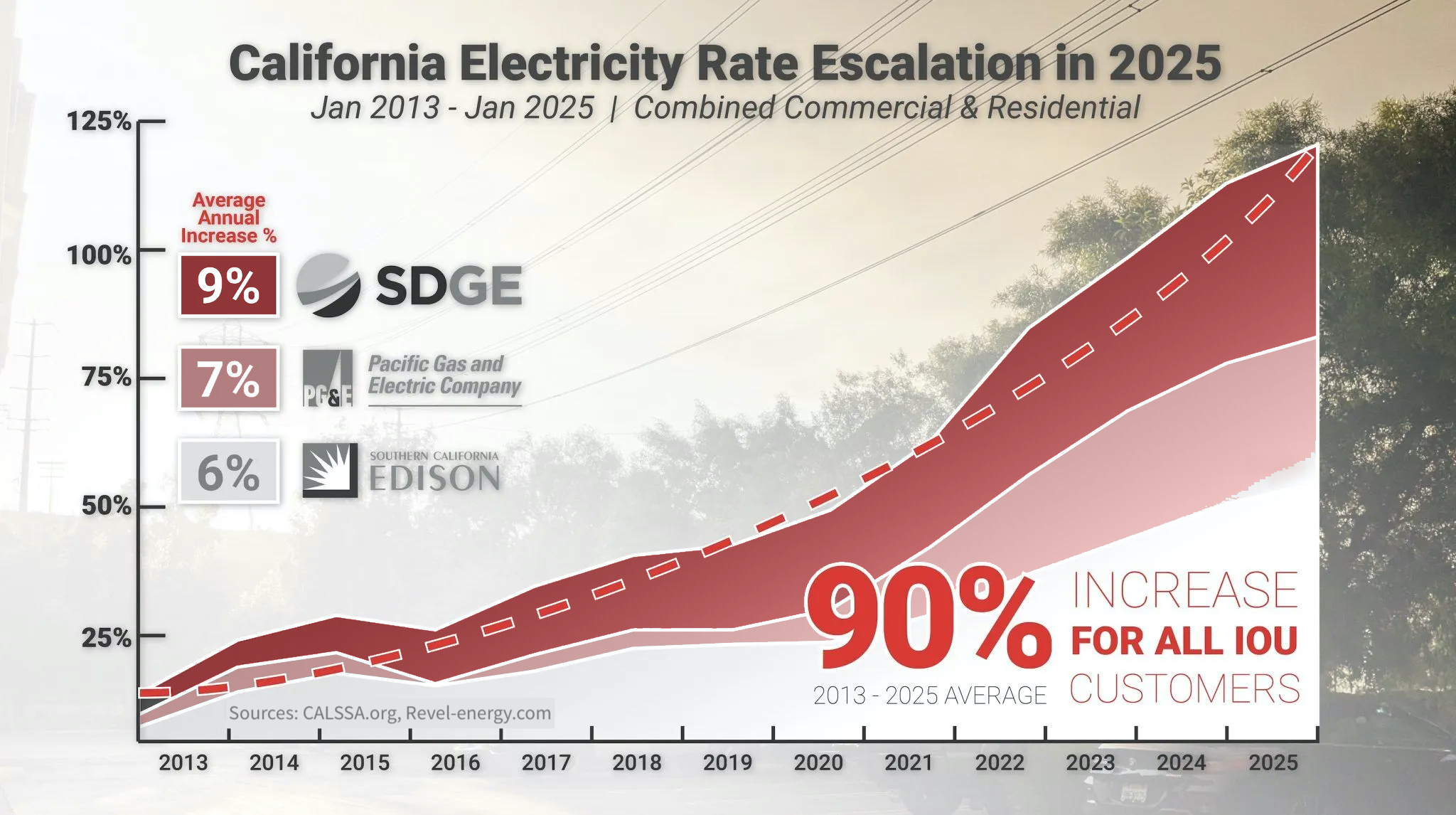image source: Revel Energy
What's the latest with energy costs in California? Here are the top 3 things you need to know for 2025:
1) Californians are still stuck with the highest energy costs in the United States - by far.-
- Per the EIA, residential electricity in California averages $0.32 per kilowatt-hour (kWh). This is 88% higher than the national average.
- Commercial electricity in California averages $0.29/kWh. This is 123% higher than the national average.
- And in Northern California where most agricultural companies operate, PG&E commercial electric rates average $0.36/kWh. 177% higher than the national average.
2) We may finally get some cost relief in 2025.
- PG&E commercial electric rates in California have grown steadily for a decade (per this chart from Revel Energy) but this year are finally set to drop about 7%.
- $2.1B in wildfire "mitigation" costs - in the form of undergrounding power lines, trimming trees, and installing fire warning systems/cameras - drove most of this rate growth over the past several years and were passed on to utility customers.
- Ag electric rates will increase in Q1, Q2, and Q4 but will drop in Q3.
- Gas rates will grow ~6% to pay for wildfire "mitigation" and gas "smart meter" infrastructure.



-
- Use extreme caution or you could end up paying much higher bills.
- Large incentives $ are being offered to enroll and help pay for automation equipment.
- Peak afternoon/evening prices can double or triple, so if you don't shut off equipment in time - or control equipment breaks - you could get stuck with a massive energy bill.

California Energy Market: The Nation's Largest And Most Expensive "Time of Use" (TOU) Energy Rate Rollout
California rolled out the nation's largest Time of Use (TOU) utility rate changes in 2021. The days of paying a "flat" rate for electricity are no more.
Time of Use: WHEN you use energy is just as important as HOW MUCH you use
Under the new TOU rates, you pay more for electricity during weekday and weekend afternoons between 5pm-8pm, seven days a week. And those costs on your utility bill are broken out between two different types of charges:
- energy consumed (i.e. the odometer) in $/kilowatt-hours ($/kWh)

- power consumed (i.e. the speedometer) in $/kilowatts ($/kW) - also known as "demand."

Confusing? YES. And it's designed to be that way so you just give up and pay your bill without asking too many questions. Hopefully these charts explain it a little more clearly:


So why is all of this changing now?
California has produced so much renewable energy in the form of solar and wind power that there's now a glut of excess power - generally in the afternoons when the sun is shining and the wind is blowing.
And let's be honest, these rate increases also siphon more money out of our pockets to go to monopoly utility companies with horrendous safety records and had to declare bankruptcy in recent years because of massive liability from sparking huge wildfires that burned down entire towns (looking at you, PG&E). Under the guise of investing in "wildfire safety measures," customers are footing the bill with much higher energy rates.
So what's the bottom line for my business?
Any businesses that use electricity during peak hours - whether for pumping irrigation water, processing crops, for office use etc - need to watch these rate increases closely to maximize their investment in on-site solar projects. Without managing "peak demand" usage between 4-9pm (commercial) or 5-8pm (agriculture), they'll likely see their original expected solar savings and ROI dwindle - and get hit with much higher bills.
Our software quickly analyzes these new TOU rates and matches them with your energy bills and consumption, your solar generation, and your irrigation pump loads over the past few years to automatically select the cheapest TOU rates and maximize your cost savings. You can also monitor and manage your peak energy usage on a daily basis, down to the equipment level. Doing this manually is simply impossible and way too time consuming.
All of these changes are clear as mud. I have a business to run. What should I do next?
You're not alone. We're seeing changes in the energy landscape faster than ever before. So leave the heavy-lifting to the energy engineers of Team Wexus.
- For more information about how Wexus can help you drive energy and water efficiency, automation and cost savings check out our home page here where you can schedule a demo of our software platform or sign up for a free proposal.
- For product and news updates, case studies and product tutorials check out our blog page here.
- Be sure to follow us for the latest updates and news on Twitter, LinkedIn and YouTube.
